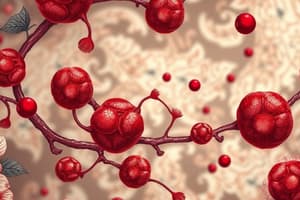Podcast
Questions and Answers
What does the coagulation cascade chart represent?
What does the coagulation cascade chart represent?
- A visual representation of all blood coagulation factors
- A diagram showing coagulation pathways
- A step-by-step flow of coagulation processes
- All of the above (correct)
What mutation is associated with Hemophilia A?
What mutation is associated with Hemophilia A?
F8 gene
What is the mode of inheritance for Hemophilia A?
What is the mode of inheritance for Hemophilia A?
X-linked recessive
What gene is mutated in Hemophilia B?
What gene is mutated in Hemophilia B?
What mode of inheritance exists for Hemophilia B?
What mode of inheritance exists for Hemophilia B?
Define variable expressivity.
Define variable expressivity.
Describe the clinical findings for severe Hemophilia.
Describe the clinical findings for severe Hemophilia.
What are the initial lab findings for a F8 and F9 mutation?
What are the initial lab findings for a F8 and F9 mutation?
What joints are most commonly affected by severe hemophilia?
What joints are most commonly affected by severe hemophilia?
What is a De novo mutation?
What is a De novo mutation?
What does APTT measurement evaluate?
What does APTT measurement evaluate?
What is the PT measurement used for?
What is the PT measurement used for?
Neither PT nor APTT can differentiate between factor deficiencies or the presence of specific factor inhibitors.
Neither PT nor APTT can differentiate between factor deficiencies or the presence of specific factor inhibitors.
Low to normal clotting activity in these screening tests completely rules out the presence of hemophilia A.
Low to normal clotting activity in these screening tests completely rules out the presence of hemophilia A.
What should all bleeding disorders be screened with?
What should all bleeding disorders be screened with?
What can be done to increase the levels of factors 8 and 9?
What can be done to increase the levels of factors 8 and 9?
What is the best screening test for platelet function disorder?
What is the best screening test for platelet function disorder?
Mutations in mild to moderate hemophilia tend to be which type?
Mutations in mild to moderate hemophilia tend to be which type?
Hemophilia affected males will transmit the mutation to all their __________ but to none of their __________.
Hemophilia affected males will transmit the mutation to all their __________ but to none of their __________.
Flashcards are hidden until you start studying
Study Notes
Hemophilia Overview
- Hemophilia is classified into two main types: Hemophilia A (mutation of the F8 gene) and Hemophilia B (mutation of the F9 gene).
- Both types exhibit X-linked recessive inheritance patterns, primarily affecting males.
Hemophilia A
- Caused by mutations in the F8 gene, leading to impaired production of coagulation Factor VIII.
- Factor VIII is crucial for proper blood coagulation.
- Severity classifications:
- Severe: < 1% normal factor activity; spontaneous joint and muscle bleeding occurs.
- Moderate: 1-5% normal factor activity; bleeding from minor trauma and postoperative.
- Mild: 5-40% normal factor activity; bleeding occurs post-operatively or after mild trauma, no spontaneous bleeding.
Hemophilia B
- Caused by mutations in the F9 gene, resulting in insufficient levels of coagulation Factor IX.
- Also characterized by X-linked recessive inheritance.
Variable Expressivity
- Refers to the varying expression of disease symptoms among affected individuals, demonstrating different levels of severity.
Laboratory Findings
- Initial lab findings for both Hemophilia A and B include:
- Prolonged activated partial thromboplastin time (APTT).
- Normal prothrombin time (PT), bleeding time, and fibrinogen levels.
- APTT is part of the intrinsic pathway of the coagulation cascade.
Genetic Transmission
- Hemophilia is not inherited from father to son because males transmit only Y chromosomes to male offspring.
- Commonly affected joints in severe hemophilia include knees, ankles, and elbows.
De Novo Mutations
- Alterations that occur for the first time in a family member, not inherited.
- Key for understanding unique cases of hemophilia.
Screening and Monitoring
- APTT is most sensitive for detecting moderate to severe hemophilia.
- APTT is also useful for monitoring heparin therapy and detecting clotting inhibitors.
- Prothrombin time (PT) measures the extrinsic pathway, useful for liver function and monitoring long-term anticoagulant therapy.
Testing and Counseling
- Essential screenings for bleeding disorders include APTT, PT, bleeding time, and platelet count.
- Specific coagulation factors are assessed based on initial screening results.
Management & Treatment
- Treatments to increase levels of factors VIII and IX include:
- Hormonal treatments (estrogens, oral contraceptives).
- Epinephrine and desmopressin acetate, the latter enhancing factor VIII levels.
- Vigorous exercise can aid in management.
Platelet Function Testing
- Bleeding time is the best screening test for platelet function disorders, prolonged in von Willebrand's disease and qualitative platelet disorders.
Mutation Types in Hemophilia
- Mild to moderate disease often linked to point or missense mutations.
- Severe disease typically associated with deletion mutations that respond poorly to therapy.
- Males with hemophilia pass the mutation to all daughters but none of their sons.
Studying That Suits You
Use AI to generate personalized quizzes and flashcards to suit your learning preferences.



